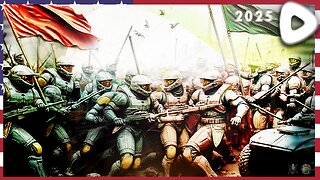Premium Only Content

Under Taker Survive Fire Show In World Circus
Under Taker Survive Fire Show In World Circus , A circus is a company of performers who put on diverse entertainment shows that may include clowns, acrobats, trained animals, trapeze acts, musicians, dancers, hoopers, tightrope walkers, jugglers, magicians, unicyclists, as well as other object manipulation and stunt-oriented artists. The term circus also describes the performance which has followed various formats through its 250-year modern history.
Although not the inventor of the medium, Philip Astley is credited as the father of the modern circus. In 1768 Astley, a skilled equestrian, began performing exhibitions of trick horse riding in an open field called Ha'Penny Hatch on the south side of the Thames River.
In 1770 he hired acrobats, tightrope walkers, jugglers and a clown to fill in the pauses between the equestrian demonstrations and thus chanced on the format which was later named a "circus". Performances developed significantly over the next fifty years, with large-scale theatrical battle reenactments becoming a significant feature.
The traditional format, in which a ringmaster introduces a variety of choreographed acts set to music, developed in the latter part of the 19th century and remained the dominant format until the 1970s.
As styles of performance have developed since the time of Astley, so too have the types of venues where these circuses have performed. The earliest modern circuses were performed in open-air structures with limited covered seating. From the late 18th to late 19th century, custom-made circus buildings (often wooden) were built with various types of seating, a centre ring, and sometimes a stage.
The traditional large tents commonly known as "big tops" were introduced in the mid-19th century as touring circuses superseded static venues. These tents eventually became the most common venue. Contemporary circuses perform in a variety of venues including tents, theatres and casinos. Many circus performances are still held in a ring, usually 13 m (42 ft) in diameter. This dimension was adopted by Astley in the late 18th century as the minimum diameter that enabled an acrobatic horse rider to stand upright on a cantering horse to perform their tricks.
#Circusshow #WorldCircus #Circusegypt
-
 24:58
24:58
RT
3 years agoCrossTalk | World Under Sanctions
24.4K54 -
 30:49
30:49
Ventor Gaming
2 years agoDigimon Survive Ep 27 - A Castle Under Siege!
5 -
 37:09
37:09
The Finance Hub
3 hours ago $0.37 earnedBREAKING: ALINA HABBA JUST SHOCKED THE WORLD!
1.92K1 -
 1:32
1:32
Memology 101
1 day ago $0.31 earnedTop Obama official SWEATING BULLETS over possible ARREST for his role in the RUSSIA COLLUSION HOAX
3.12K11 -
 3:37:50
3:37:50
sophiesnazz
4 hours ago $2.58 earnedTIME TO WIND PEOPLE UP !socials
19.2K1 -
 LIVE
LIVE
OhHiMark1776
4 hours ago🟢07-26-25 ||||| Halo Multiplayer Rumble: No. 16 ||||| Halo MCC (2019)
55 watching -

GamerGril
4 hours agoThe E-Gril Within | First Time Play Through | Saturday Spookfest
16.4K1 -
 18:22
18:22
Liz Wheeler
5 hours agoWhat Ghislaine Maxwell Knows
18.5K25 -
 2:59:10
2:59:10
cosmicvandenim
8 hours agoWARZONE - Kenetik Energy Announcement - Discord Spy Bots
16.9K -
 1:05:51
1:05:51
Jeff Ahern
5 hours ago $19.62 earnedThe Saturday Show with Jeff Ahern
106K20